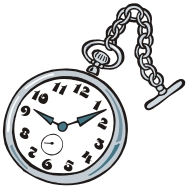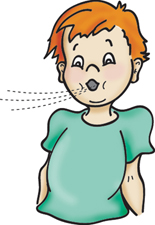Begin
the investigation by encouraging students to give an example of
something that they do once a day such as eat breakfast, listen to
school announcements, or play with a friend. Ask them to name something
they do about ten times each day, which might include saying hello in
the hall, changing the television channel, or writing their names on
papers. Finally ask students to name something that they do at least
one hundred times a day. A narrow range of responses often includes
blinking and breathing. If not, take a deep breath and ask, "What about
breathing?"
Ask students, "Do you take more than 100 breaths in a day? More than 100 or 1000 breaths in an hour?"

After a brief discussion, distribute the Every Breath You Take
activity sheet and ask each student to estimate the number of breaths a
person takes each hour. Have each student write down an estimate.
 Every Breath You Take Activity Sheet
Every Breath You Take Activity Sheet
Students should work with a partner to answer questions 3 and 4.
Have each pair share its response with another pair. As a class,
discuss similarities and differences in data interpretation that
surfaced when sharing observations.
To explore the data further, have each student use his or her
estimate from question 1 and line up in order. Each students will
determine his or her place in line without assistance.
The student with the lowest estimate should start by reading the
estimate to the class. Determine the range by identifying the lowest
and highest estimates, noting how much easier they are to find when the
data points are so displayed. Ask students whether it is more obvious
that some estimates appear to "bunch" or "cluster" around certain
values or whether the estimates appear to be evenly distributed when
students are lined up than when the numbers are listed on paper.
 Grid Paper
Grid Paper
Each student should construct a graph of the class data using graph paper.
Discuss an appropriate scale and label for the graph's vertical axis.
Students will also need to determine whether to plot a scatter graph or
a bar graph, depending on prior experience. Note that student estimates
may vary widely, so you made need to use ranges of data for each of the
bars in a bar graph. For example, you may have 0-60, 61-120, 121-180,
and so on for the number of breaths estimated.
Explore the data in terms of, for example, an approximate mean, the median, and the outliers.
Discuss what makes a good estimate and more than one estimate may be good.
Encourage students to explore how they might use their estimates of
the number of breaths taken in one hour to estimate the number taken in
a day. Students who have been exposed to multiplication might suggest
multiplying their estimates by 24, whereas other children might use a
repeated-addition process on their calculators.
Discuss why this estimate might be considerably different from the actual number of breaths taken in a day.
To judge the reasonableness of student's estimates, ask, "How could
you find out how many breaths a person actually takes in a day?" Allow
students to brainstorm solving the problem. They might work with a
partner and count the number of breaths in a given period of time—for
instance, one minute—or determine the time it takes to breathe a given
number of times, say, one hundred.


Have students implement their strategies and compare their
answer with one another. On the activity sheet, students should also
describe and defend the methods they chose to use.
Conclude the investigation by encouraging students to look for
other things that are done many times every day in their world. By
counting the number of times that we do these things, a sense of large
numbers and a familiarity with them may be established.